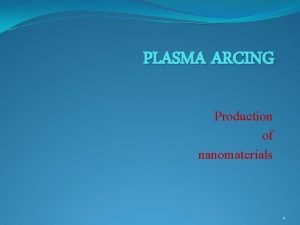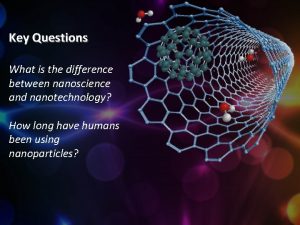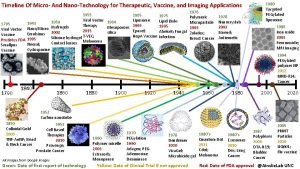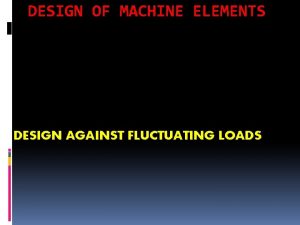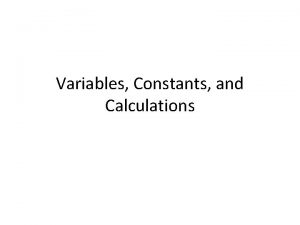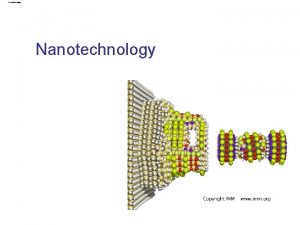CALCULATIONS IN NANOTECHNOLOGY TASNEEM KAPADIA 60011115023 NANOTECHNOLOGY Nanotechnology
























- Slides: 24

CALCULATIONS IN NANOTECHNOLOGY TASNEEM KAPADIA 60011115023

NANOTECHNOLOGY Nanotechnology is the understanding and control of matter at dimensions of roughly 1 to 100 nanometers. This is the world of atoms, molecules, macromolecules, quantum dots, and macromolecular assemblies.

Relationship between Nanoscience and Quantum Mechanics


Particle size Distribution Particle size influences many properties of particulate materials and is a valuable indicator of quality and performance. It determines: appearance and gloss of paint flavor of cocoa powder reflectivity of highway paint hydration rate & strength of cement properties of die filling powder absorption rates of pharmaceuticals appearances of cosmetics

Particle size distribution Number weighted distributions: Particle size doesn’t matter only number of particles Volume weighted distributions: The relative contribution will be proportional to (size)3, distribution represents the composition of the sample in terms of its volume/mass, and therefore its potential $ value. Intensity weighted distributions: Dynamic light scattering techniques will give the contribution of each particle in the distribution relating to the intensity of light scattered by the particle. For example, using the Rayleigh approximation, the relative contribution for very small particles will be proportional to (size)6.

Mean, Median & Mode

ZETA POTENTIAL Zeta potential is a measure of the magnitude of the electrostatic or charge repulsion or attraction between particles in a liquid suspension. It is one of the fundamental parameters known to affect dispersion stability. Its measurement brings detailed insight into the causes of dispersion, aggregation or flocculation, and can be applied to improve the formulation of dispersions, emulsions and suspensions.

Particle size measurement methods Dynamic Light Scattering (DLS) Differential Centrifugal Sedimentation (DCS) Transmission Electron Microscopy (TEM) Scanning Electron Microscopy (SEM) Asymmetric flow- field flow fractionation (AFFF) Particle Tracking Analysis (PTA)

DCS DLS

AFFFF

Fluid Particle Dynamics

Fluid dynamic mechanism

Terminal Particle Settling Velocity

Determination of flow regime

Cunnigham correction factor At very low reynold numbers, when the particle size is comparable with the mean free path of fluid molecules, the medium is no longer continuous. The particles fall between the molecules at a faster rate than explained by aerodynamics. To allow this slip, Cunningham introduced a factor to Stoke’s equation, Where, Cunningham correction factor The modified stoke’s- Cunningham equation is On further simplification with kinetic theory of gases:

Brownian Motion • Particles suspended in a gas or liquid seem to move around randomly as they are pushed to and fro by collisions with the atoms that comprise the gas or liquid. • Brownian motion of a particle in the fluid is a result of thermal fluctuations surrounding the particle THE DEAD CAN DANCE TOO

Particle collection mechanism The overall collection/removal process for particulates in a fluid takes place in 4 steps: Application of external force velocity directs of retrieval section, Retention at the retrieval area, As particles get accumulated, they are subsequently removed, Ultimate disposition completes the process.

Particle collection mechanism and efficiency Brownian motion : Diffusion occurs when smaller particles having Brownian motion hit the surface of the fibers

Centrifugal force: The shape of the collector causes the gas to rotate. The Heavier particles move towards the wall and lose kinetic energy and hence Fall down and get separated. The drift velocity, number of Rotations and residence time affects the efficiency.

Interception: Interception occurs when particles do not depart from the streamlines. The inertia or Brownian motion of particles is negligible. Particles following streamlines arrive at the fibers and get "intercepted" on the fiber surface. Interception parameter NR=Dp (particle diameter)/Df (fiber diameter) Inertia impaction: This occurs when particles cannot adjust to the "sudden" change of streamlines near fibers, and, due to inertia, depart from the streamlines and impact on the fiber surface.


Electrostatic attraction: The charged particles are subjected to a strong electrical field to overcome the drag force of the fluid. Combined effect of direct impaction, interception and electrostatic attraction. Electrostatic force, Fe=q Ep, where, q: particle charge Ep: collection field intensity Gravity: When the only significant force acting on a particle is the gravity, then this mode of deposition is called sedimentation, or gravitational settling.

THANK YOU!
 Samir kapadia md
Samir kapadia md Samir kapadia, md
Samir kapadia, md Types of connections in steel structures
Types of connections in steel structures Tasneem essaji
Tasneem essaji Tasneem khatib cambridge
Tasneem khatib cambridge Dr tasneem vet
Dr tasneem vet Plasma arcing
Plasma arcing Nanotechnology for kids
Nanotechnology for kids Nanotechnology
Nanotechnology Advantage of nanotechnology
Advantage of nanotechnology Difference between nanoscience and nanotechnology
Difference between nanoscience and nanotechnology Nanotechnology definition
Nanotechnology definition Tennis ball nanotechnology
Tennis ball nanotechnology Nanotechnology
Nanotechnology Conclusion of nanotechnology
Conclusion of nanotechnology Timeline of nanotechnology
Timeline of nanotechnology What is nanotechnology
What is nanotechnology Fact or myth nanotechnology
Fact or myth nanotechnology What is nanotechnology
What is nanotechnology Interpretations of moore's law assert that
Interpretations of moore's law assert that Nbic, gnr, grain, bang
Nbic, gnr, grain, bang Journal of nanoscience and nanotechnology sci
Journal of nanoscience and nanotechnology sci Disadvantages of nanotechnology
Disadvantages of nanotechnology Thinking algebraically stock market game answer key
Thinking algebraically stock market game answer key Goodman method for combination of stresses
Goodman method for combination of stresses






